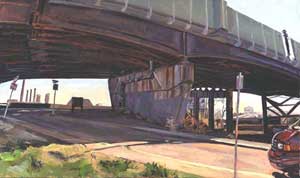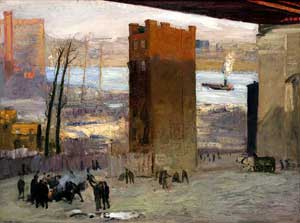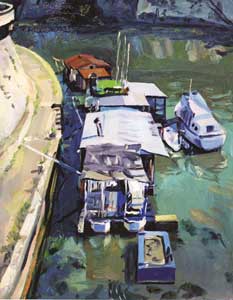
George Nick Rt 93 2005 oil on linen 36 x 60 inches
Interview with George Nick Part Three, On George Bellows
Larry Groff:
You’ve expressed affinity with the Ashcan School of Painters, such as George Bellows. What aspect of this work interests you the most? Is there such a thing as Neo-Ashcan, and if so, would you be a part of it?
George Nick:
Well, first of all, I don’t think George Bellows is part of the Ashcan School. I think there were several others that were considered that group.
I love George Bellows a lot, and I like the Ashcan School, but I don’t think they’re affiliated. I think they’re about the same time. He was not a typical — they all did these scenes of the Third Avenue Elevated, and the people in the backyards with wash, and all this kind of stuff. Drinking in bars — all this local genre kind of painting.
Bellows didn’t do any of that. He did some really wonderful landscapes. He did some wonderful portraits and he did these series of making public art for a name for himself, about the fighters and things like that, and portraits of his daughter. That was his classical period.
I think he’s really a fine artist, and I’m really impressed with the smaller ones he did of lakes or little views of Maine or something like this. Very inventive, very emotional, very tied in with the idea of expression. He’s not in any school. I’m not a joiner, so I wouldn’t be a part of anything like that.
But those are some of the things about Bellows that I liked a lot. I missed getting a book of his, because $140 was a lot for a small book. I thought about it twice; by the time I thought that I should get it — it was a book in black and white of a lot of his landscapes. And I missed that, and I don’t even know how to find it now.
George Nick:
But there’s some beautiful things that I’ve seen him do, beautiful things, and of different styles, because he was changing his styles while he was growing. But he died early, in his forties. I think he is a major American painter. There was so much life in him.

George Bellows The Lone Tenement 1909 oil on canvas 36 x 48 inches
There’s like one painting — I think it’s at the National Gallery — of the view of New York from building the tunnel or a bridge, or something like this, in the snow. It’s a really remarkable, crude, evocative painting. It’s very raw, and it’s very vigorous, at the same time. I think he’s one of most dangerous, inventive painters of the period.
LG:
In that painting that’s in the National Gallery, that you were just describing, that was all done in the studio from studies, or memory?
George Nick:
No, I don’t think so. I think those are done on the spot.
LG:
It really looks that way, but it just seemed like it was so large, it would have been very difficult.
George Nick:
What do you mean? I’ve worked outside on a 50 x 80 inch canvas.
LG:
Well, I know, I guess thinking of all the people, and the horses and the snow.
George Nick:
Well, he’s away from that. I’m sure nobody paid any attention to him. I mean, it’s a cold, winter’s day and they’re working. Nobody’s sitting around on a hot summer’s day having lunch. They were all working. So, he was working, too. They didn’t pay any attention to him, I don’t think.
LG:
It’s an amazing painting.
George Nick:
Isn’t it?
LG:
It’s one of my all-time favorites.

George Nick Ponte Caqvour Roma 2005 oil on linen
George Nick:
Right, that’s one of the reasons I like him so much. If you keep looking around, I found a painting up — I forgot where we were. We were coming through Maine, and we stopped off [in] a little town, where there was this college it was Colby College, and they had an art collection, and in that — oh, they had a roomful of Alex Katz that somebody had given to the school. They built this wing for Alex Katz.
But around the corner was this little painting of a couple of waves, almost in black and white, and it was the most beautiful thing I saw. It was a Bellows.
George Nick:
It’s wonderful to see that. Seeing that water was unbelievable; I mean, unbelievable painting. The solidity of water on a gray day, falling wave — a falling wave, that’s all it was. A small painting, maybe about 16 x 20 or something like that. And it was one of the most powerful things I’ve ever seen.
(note to readers, I was unable to find this exact painting from Colby College – if anyone has a link to this image or know its current location, please contact me and I will try to include it in this article)
LG:
Excellent. Do you have anything else that you want to say about George Bellows? Or your work in relation to his? What inspired you from seeing his work?
George Nick:
His work is good.
LG:
There you go. That’s a connection.
To Interview with George Nick, Part One, On Edwin Dickinson
To Interview with George Nick, Part Two, On Fairfield Porter
To Interview with George Nick Part Three, On George Bellows
To Interview with George Nick Part Four, On Cezanne and color
To Interview with George Nick Part Five, On Drawing
To Interview with George Nick Part Six, On The Trojan Horse and thoughts on Teaching





Here’s a substantial online archive of Bellows containing many paintings of waves.
http://www.the-athenaeum.org/art/by_artist.php?&sort=&id=97&p=1
http://www.the-athenaeum.org/art/by_artist.php?&sort=&id=97&p=2
Note: For those who take good digital images while in museums/galleries, you can upload them to this site and make it better!
Thanks David, I saw that site as well and sent it to George but I don’t think he saw it there either.
Another site with even more Bellows images is the dedicated http://www.georgewesleybellows.org website…
here is one painting of a wave but George says it isn’t the one. I found maybe 25 or so other paintings with waves and breakers and coves there so maybe it’s one of those.
http://www.georgewesleybellows.org/Wave.html
I love this painting of the wave…
Larry, I’m almost sure I saw that same Bellows painting of the wave at the Farnsworth in Rockland, Maine a few years ago. The one I saw was part of a larger exhibition of American paintings and they may have borrowed it from Colby College.
I’m really enjoying the interview. Good job.
I agree, “Sea in Fog” at the Farnsworth-could have been purchased for the Farnsworth by Robert Bellows.
The Georgia Museum of Art in Athens has a lovely Monhegan painting, “Fog Breakers”
Tell George “hello” for me-we still love his painting at the Bradley Co. in Columbus, Ga.
nice interview, but i came here for the bellows. There’s an awesome wave painting in the Columbus Museum. I’ve been waking up to Bellows’ power. i don’t believe G Nick when he says Bellows was not part of the ash can school, he painted the tenements and poor over and over, and his aesthetics were in-line. He may have had different concerns and he may have been better than the rest (he is the best) but it doesn’t make sense in my mind.
But I’ve been thinking that Bellows is one of the greats of all time! he had a quick lithe energy a feel to volume and color that were basically unknown. he also had a very brilliant mechanicalism or phenomenology to his painting where be “built” with paint, sometimes he just built air, but it was “built”.
Just saw the Bellows show at the Met. Yes, the early work certainly is powerful, wonderful. Of course Bellows is part of the Ashcan School, albeit a bit younger than the “official” group, his work, like Cliff Dwellers is classic Ashcan! He was a student of Robert Henri, and took Henri’s advice as a basis for much of his best work. But what happens in the room with the Tennis Courts and Polo games is truly tragic. He declines so severely into mannerisms and acid color that make you wince. Clearly he could still draw, and show he still had “it”, but smothered it in bad painting, sentimentality and metalic stylizations.